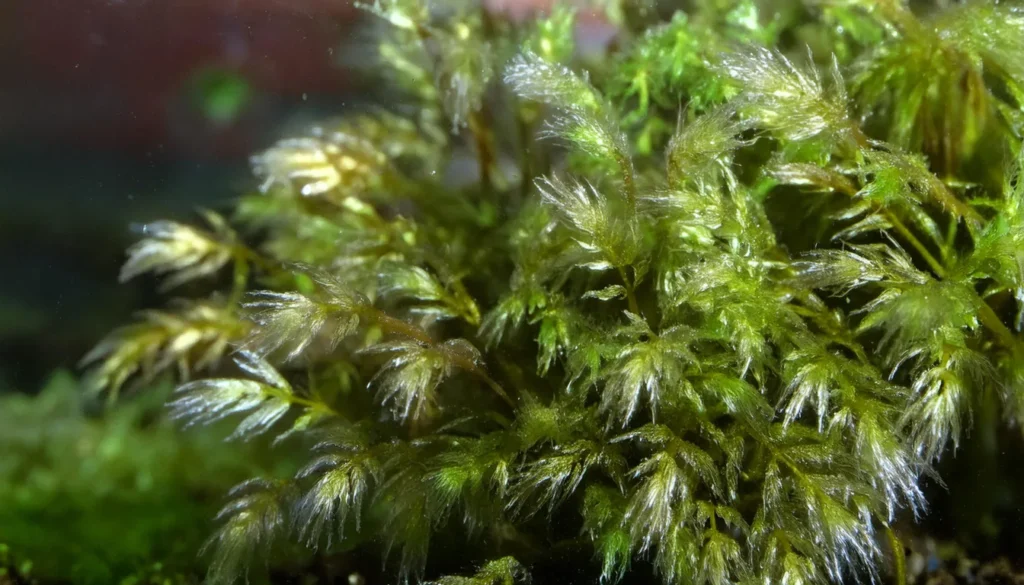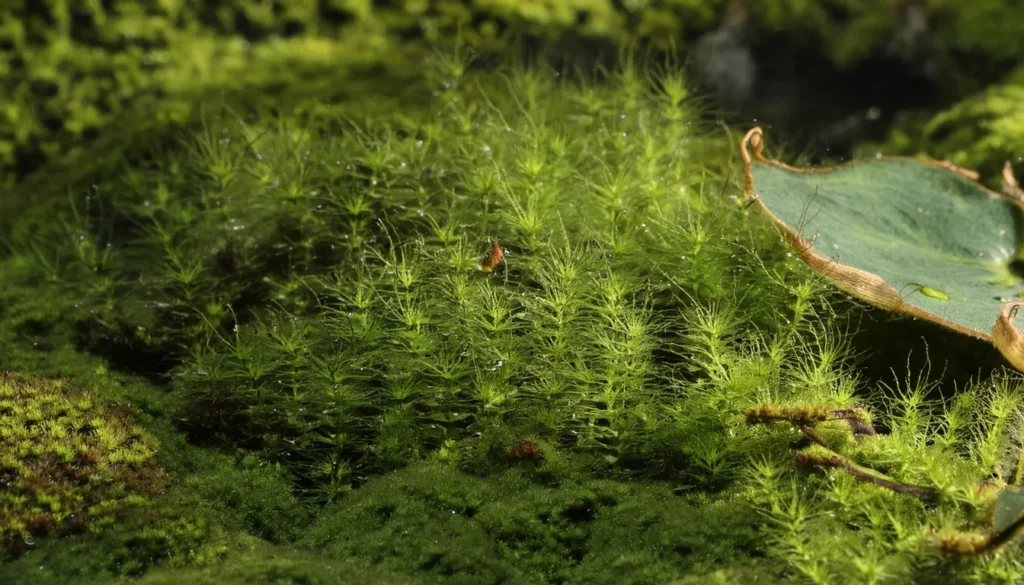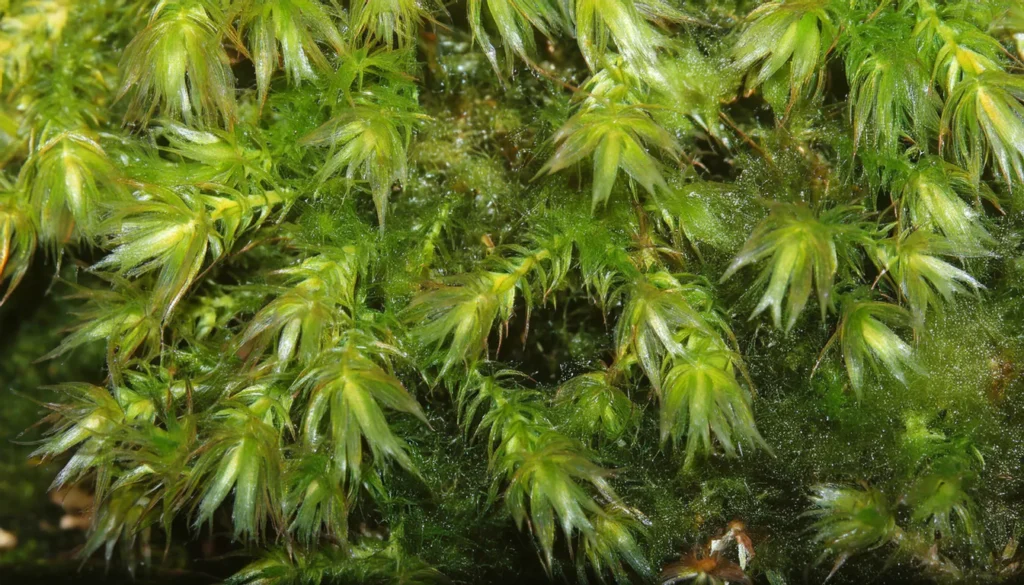Welcome to our guide on using Leptodictyum riparium, also known as stringy moss, in aquatic design.
This visually stunning aquatic plant has captured the attention of aquascapers worldwide for its unique and attractive appearance.
In this article, we will delve into the identifying characteristics of Leptodictyum riparium, its natural habitat, growth requirements, and its aesthetic appeal to aquascaping.

Key Takeaway
- Leptodictyum riparium, also known as stringy moss, is popular among aquascapers for its unique and attractive appearance.
- It is characterized by long, string-like stems that form a dense carpet-like appearance.
- Leptodictyum riparium can be used in various ways to create stunning designs in aquariums, including as a foreground or midground plant or in the background to create vertical interest.
- The visual texture and delicate look of stringy moss add elegance to any aquascape.
- Leptodictyum riparium offers several health benefits in aquariums, including improved water quality and benefits for fish and other aquatic creatures.
Quick Stats
| Attribute | Details |
| Family Name | Amblystegiaceae |
| Origin | Cosmopolitan |
| Height | Can grow strands up to 20 cm (8 inches) long |
| pH Range | 5.0 – 8.0 |
| CO2 Requirement | Low |
| Growth Rate | Slow to Moderate |
| Care Level | Easy |
| Color Form | Bright to Dark Green |
| Water Conditions | 4-28°C (39-82°F), adaptable to a wide range of hardness |
| Max Size | Strands can grow quite long, typically trimmed to desired length |
| Lighting | Low to Moderate |
| Supplements | Benefits from liquid fertilizers, but not necessary |
| Placement | Attached to hardscape or left free-floating |
| Propagation | Fragmentation |
Natural Habitat And Range
Leptodictyum riparium is primarily found in wet environments like riverbanks, streams, and wetlands.
It thrives in areas with high humidity and moderate to low light conditions.
The plant has a wide range and can be found in various regions worldwide.
Physical Characteristics
- Growth Form: It features a distinctive feather-like or plume-like growth form, with slender stems branching out in a delicate, fern-like pattern.
- Stem Structure: The stems of Leptodictyum riparium are thin and wiry, typically ranging from light to dark green in color. They may grow upright or cascade gracefully over surfaces, creating an elegant appearance.
- Foliage: The foliage of Leptodictyum riparium consists of tiny, overlapping leaves arranged along the stems. These leaves are typically lance-shaped or needle-like, contributing to the plant’s feathery texture and appearance.
- Texture: The overall texture of Leptodictyum riparium is soft and feathery, resembling the delicate fronds of ferns. This texture adds depth and visual interest to aquarium landscapes.
- Size: In aquariums, Leptodictyum riparium typically grows to a moderate height, ranging from a few inches to several inches tall, depending on environmental conditions and pruning.

Lighting Conditions For Growth
- Proper lighting conditions are essential for the healthy growth of Leptodictyum riparium. This aquatic plant thrives under moderate to high lighting levels, usually ranging from 2 to 3 watts per gallon of water.
- It is advisable to choose LED lights specifically designed for aquariums, as they provide the appropriate spectrum and intensity required for optimal plant growth.
Optimal Water Condition
- Temperature: Maintain the water temperature between 18-24°C (64-75°F). This temperature range mimics the natural habitat of Leptodictyum riparium and promotes healthy growth without subjecting it to extreme fluctuations.
- pH Level: Aim for a slightly acidic to neutral pH range of 6.0-7.5. This range ensures that essential nutrients remain accessible to the plant while preventing pH-related stress.
- Water Hardness: Leptodictyum riparium can tolerate a wide range of water hardness levels. However, a moderate to slightly hard water with a general hardness (GH) of 5-15 dGH is generally suitable.
- Lighting: Provide moderate to high-intensity lighting, preferably in the range of 0.5-2 watts per gallon, to support photosynthesis and healthy growth. Avoid intense lighting that may cause algae issues or light stress to the plant.

Suitable Temperature For Growth
The suitable temperature range for the optimal growth of Leptodictyum riparium is between 18-24°C (64-75°F).
Within this range, the plant can thrive and exhibit healthy growth without being subjected to extreme temperature fluctuations.
Maintaining a stable and suitable temperature ensures that Leptodictyum riparium can photosynthesize efficiently and absorb nutrients from the water, promoting lush and vibrant foliage in the aquarium.
Selecting The Right Substrate For Leptodictyum Riparium
- Choosing the right substrate is a crucial component of successful aquascaping with Leptodictyum riparium.
- The substrate provides a stable foundation for the plants and plays a vital role in nutrient absorption and root development.
- Using a fine-grained substrate that allows water circulation and prevents debris accumulation is recommended.
Placement Option In The Tank
- Foreground Planting: Place Leptodictyum riparium at the front of the aquarium to create a lush and visually appealing foreground. Its delicate fronds and feathery texture add depth and dimension to the lower portion of the tank.
- Midground Accent: Position Leptodictyum riparium in the midground area of the aquarium to serve as a focal point or accent plant. Its graceful growth form and soft foliage create an eye-catching centerpiece amidst other aquatic plants.
- Background Coverage: Use Leptodictyum riparium to cover background surfaces such as rocks, driftwood, or aquarium walls. Allow its wiry stems to cascade over hardscape elements, creating a naturalistic backdrop and softening hard lines in the aquarium.
- Vertical Planting: Attach Leptodictyum riparium to vertical surfaces such as aquarium walls or tall background structures. Its upright growth habit and cascading fronds create a visually striking vertical accent, adding interest to the aquascape.

Recommended Tank Size
- The recommended tank size for Leptodictyum riparium, or Plume Moss, depends on several factors including the aquascape design, other tank inhabitants, and personal preference. However, for optimal growth and visual impact, a tank size of at least 10 gallons (approximately 38 liters) is recommended.
- This size provides sufficient space for planting Leptodictyum riparium and allows it to establish its delicate fronds and wiry stems. Larger tanks, such as 20 gallons or more, offer even more space for creativity in aquascaping and can accommodate a more extensive planting of Plume Moss, creating a lush and vibrant display.
- Consider the overall dimensions and layout of the tank, as well as the needs of other aquatic inhabitants, when determining the ideal tank size for Leptodictyum riparium. Providing ample space will allow the plant to thrive and contribute to the beauty and health of your aquarium ecosystem.
RELATED: Creating A Stunning Red Accent With Ammania Senegalensis At Home
Suitable Tank Mates
- Amphibians: Certain species of frogs, such as dart frogs, tree frogs, or newts, can coexist peacefully with Plume Moss in a paludarium setup. Ensure the amphibians’ habitat requirements align with the environmental conditions of the tank.
- Small Reptiles: Some small reptiles, such as geckos or anoles, may thrive in a paludarium environment alongside Plume Moss. Ensure proper temperature, humidity, and hiding spots are provided for the reptiles’ well-being.
- Invertebrates: Certain species of terrestrial or semi-aquatic invertebrates, such as land snails or hermit crabs, can complement a Plume Moss habitat in a paludarium. Ensure the invertebrates’ needs for humidity, substrate, and shelter are met.
- Fish: In some setups, it’s possible to incorporate small, non-aggressive fish species that can tolerate both aquatic and semi-aquatic environments. However, it’s essential to carefully monitor water quality and ensure the fish are compatible with the other inhabitants and habitat conditions.

Nutritional Needs Of The Plant
- Water Absorption: Plume Moss absorbs water and nutrients through its delicate fronds and stems. It relies on high humidity levels within its environment to facilitate nutrient uptake. Regular misting or maintaining a humid environment in the terrarium helps ensure adequate hydration and nutrient absorption.
- Airborne Nutrients: Plume Moss can absorb nutrients from the air, including nitrogen, carbon dioxide, and trace minerals. It benefits from good air circulation within the terrarium, which helps supply fresh air and nutrients to the plant.
- Substrate: While Plume Moss does not heavily rely on substrate for nutrients, providing a nutrient-rich substrate can indirectly support its growth. A well-draining substrate with organic matter can help maintain humidity levels and provide stability for the moss to anchor onto.
- Fertilization: Plume Moss typically does not require fertilization like aquatic plants. However, if growth appears sluggish or the moss exhibits signs of nutrient deficiency, you can provide occasional fertilization with a diluted, balanced liquid fertilizer formulated for terrarium plants. Use fertilizers sparingly to avoid over-fertilization, which can harm the moss.

Leptodictyum Riparium Cultivation Tips
- Humidity: Plume Moss thrives in high humidity environments. Maintain humidity levels of 50-80% within the terrarium by misting the moss regularly with water or using a humidity monitor and humidifier to regulate moisture levels.
- Lighting: Provide moderate to bright, indirect light for Plume Moss. Position the terrarium in a location with access to natural light or use full-spectrum LED grow lights to simulate sunlight. Avoid direct sunlight, as it can cause the moss to dry out or become scorched.
- Air Circulation: Ensure adequate air circulation within the terrarium to prevent stagnant air and promote gas exchange. Gentle airflow helps prevent mold and mildew growth while supplying fresh air and nutrients to the moss. Use fans or provide ventilation openings as needed.
- Substrate: While Plume Moss can grow attached to various surfaces, including rocks, wood, or soil, it doesn’t require a traditional substrate. However, providing a well-draining substrate with organic matter can help maintain humidity levels and provide stability for the moss to anchor onto.
Plant Propagation Tips
- Division: Plume Moss can be propagated by dividing existing clumps or patches. Gently separate the moss into smaller sections, ensuring that each section has healthy fronds and stems. Plant the divided sections in suitable locations within the terrarium or vivarium, ensuring they receive adequate light and moisture.
- Cuttings: Take stem cuttings from healthy portions of the moss and plant them in the desired location within the terrarium. Ensure that each cutting has several fronds and stems intact. Plant the cuttings in moist substrate or attach them to hardscape elements using aquarium-safe adhesive or thread.
- Spores: Plume Moss reproduces through spores, which are tiny reproductive structures produced by the plant. To propagate Plume Moss from spores, collect mature spores from the underside of the moss fronds using a clean, dry brush or cotton swab. Sprinkle the spores onto moist substrate or sphagnum moss within the terrarium and maintain high humidity to encourage germination.
- Encouraging Growth: Provide optimal environmental conditions, including high humidity, moderate to bright, indirect light, and adequate air circulation, to encourage rapid growth and propagation of Plume Moss. Regular misting and maintenance will help ensure that the propagated moss establishes itself successfully.
Benefits Of Planting Leptodictyum Riparium
- Aesthetic Enhancement: Plume Moss adds natural beauty and texture to terrariums and vivariums, creating a lush and verdant landscape reminiscent of forest floors or tropical habitats. Its delicate fronds and wiry stems provide visual interest and depth to the planted enclosure.
- Naturalistic Environment: Plume Moss contributes to the creation of a naturalistic environment within the terrarium or vivarium, enhancing the overall ambiance and authenticity of the setup. Its presence mimics the appearance of moss-covered rocks, fallen logs, or forest understories found in natural ecosystems.
- Humidity Regulation: Plume Moss helps regulate humidity levels within the terrarium or vivarium by absorbing moisture from the air and releasing it gradually. This benefits moisture-loving plants and inhabitants, ensuring a comfortable and stable environment for their well-being.
- Air Purification: Like other moss species, Plume Moss can help improve air quality within the terrarium by absorbing airborne pollutants and toxins. It acts as a natural air purifier, promoting a healthier and more oxygen-rich environment for plants and animals alike.

Conclusion
Leptodictyum riparium, commonly known as stringy moss, is a visually stunning and versatile aquatic plant that has captured the hearts of aquascapers worldwide.
Its delicate texture and cascading growth habit make it a unique and visually appealing addition to any aquatic design.
Whether used as a foreground carpet or as a background accent, Leptodictyum riparium adds depth, complexity, and elegance to aquascapes.
One of the key advantages of Leptodictyum riparium is its ease of care.
This hardy plant thrives in many water conditions and requires minimal maintenance.
It actively improves water quality by absorbing excess nutrients, creating a balanced and healthy environment for fish and other aquatic creatures.
For beginners in the world of aquascaping, Leptodictyum riparium is an ideal choice.
Its forgiving nature and relatively simple care requirements make it a great option for those starting their aquascaping journey.
With Leptodictyum riparium, aquascapers of all levels can create beautiful and captivating underwater landscapes.
Frequently Asked Questions
How Can I Get Design Inspiration For Using Leptodictyum Riparium?
Drawing design inspiration from successful aquascapes featuring Leptodictyum riparium can help you create stunning underwater landscapes in your own aquarium.
Countless examples of aquascapes incorporate Leptodictyum riparium in different ways, from creating intricate carpet patterns to using it as a focal point in the design.
What Are The Benefits Of Leptodictyum Riparium Compared To Other Aquatic Moss Varieties?
Leptodictyum riparium offers unique characteristics and benefits compared to other aquatic moss species. These include contrasting texture and growth patterns and their suitability for various aquascaping designs.
What Tools And Supplies Do I Need For Aquascaping With Leptodictyum Riparium?
When aquascaping with Leptodictyum riparium, it is important to have the right tools and supplies on hand. This includes selecting the right substrate and ensuring appropriate lighting conditions for optimal growth.
What Are Some Tips For Beginners In Using Leptodictyum Riparium?
Leptodictyum riparium can be an excellent choice for beginners due to its relatively easy care requirements and forgiving nature.
Some tips for beginners include starting with the proper equipment and ensuring the right conditions for growth.
Can You Provide Real-World Examples Of Leptodictyum Riparium In Design?
Yes, this section presents real-world examples of Leptodictyum riparium in design.
These case studies showcase various layouts, styles, and techniques demonstrating the versatility and aesthetic appeal of using Leptodictyum riparium in different aquascapes.
- Unveiling The Wonders Of Riccia Fluitans In Aquascapes - August 7, 2024
- Vallisneria Gigantea Var. Guide To Care And Cultivation At Home - July 31, 2024
- Vesicularia Dubyana Care & Growth Guide Tips For Beginner Gardeners - July 30, 2024
